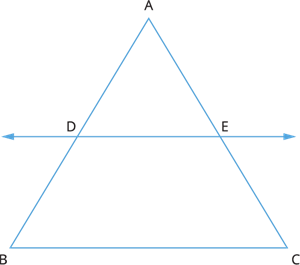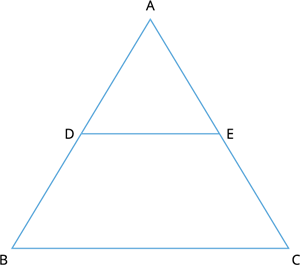PDF chapter test TRY NOW
Let us learn how to apply theorems to solve problems.
Example:
1. In a \triangle ABC, a straight line DE intersects AB at D and AC at E and is parallel to BC, then prove that \frac{AB}{AD} = \frac{AC}{AE}
Solution:

By Thales theorem, we have:
\frac{AD}{DB} = \frac{AE}{EC}
\frac{DB}{AD} = \frac{EC}{AE}
Adding 1 on both sides of the equation, we have:
\frac{DB}{AD} + 1 = \frac{EC}{AE} + 1
\frac{DB + AD}{AD} = \frac{EC + AE}{AE}
\frac{AB}{AD} = \frac{AC}{AE}
Hence, we proved.
2. In a \triangle ABC, D and E are points on AB and AC respectively such that \frac{AD}{DB} = \frac{AE}{EC} and \angle ADE = \angle DEA. Prove that \triangle ABC is isosceles.
Solution:

Given that \frac{AD}{DB} = \frac{AE}{EC}, then by the converse of Thales theorem, we have:
DE \parallel BC
Therefore, \angle ADE = \angle ABC [Corresponding angles] ---- (1)
and \angle DEA = \angle BCA [Corresponding angles] ---- (2)
But, it is given that \angle ADE = \angle DEA ---- (3)
Using (1) and (2) in equation (3), we get:
\angle ABC = \angle BCA
Therefore, AC = AB [If opposite angles are equal, then opposite sides are equal.]
Thus, \triangle ABC is isosceles.
Hence, we proved.
